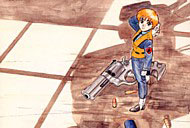
Patlabor: The Original Series (OVAs)
How long is the shelf life of a series? We saw the last section of Urusei Yatsura by 1991, if memory serves, 10 years after its animated inception. The Lupin III movies keep on coming; considering we first saw the gentleman thief on screen in 1971, it's clear that it's a series that now spans generations. Although not a top tier title like these two classics, Patlabor continues to be remembered fondly in "older" anime circles that saw its debut in 1988. The fact that a third movie in the Patlabor universe could be released fourteen years after its first appearance (and nine years after the second film) shows that folks are still intrigued with its world. It's not flashy, and the quality of the animation in the original seven OVAs that kicked it off is dubious, but it is certainly one of the most uniquely enjoyable shows to watch in the scope of Japanese animation even today.
In an (obviously alternate) 1990s Japan, special machines called Labors have been put to use, revolutionizing industries and being a great boost to society. However, the criminal element realizes the potential of Labors and starts using them in crime. Hence, the city creates the Patrol Labor (or Patlabor) unit to deal with issues revolving around the use of mecha. Noa Izumi is a raw recruit, a tomboy who is chomping at the bit to have her own Labor. She's a perky gal, but she's not the only newbie -- in fact, the Patlabor unit is teeming with them. Although each one's personality is different, they're managed by the laconic Gotoh. The man looks like he can barely keep his eyes open and acts like nothing interests him, but it's a facade concealing a capable leader. The question is, can a ragtag team take on seasoned criminals and live to tell about it?
Although the initial concept of "raw recruits in training" is a tired commodity, Patlabor is not interested in telling us about the team getting better or really even much about their taking down of criminals. Patlabor as a series (at least in the OVAs) works because it is actually a true ensemble drama. Noa Izumi does get a lot of press -- her face created the spine-scene on the original VHS release, after all -- but the show is only interested in her as a part of a team. Anime has plenty of "team" shows from Sailor Moon to the recently revived Gatchaman, but rarely are the teams big enough (or developed enough) to be interesting outside of a formulaic plot. With Patlabor, it's the opposite -- we get bored by a couple of OVAs with only passable narratives because these characters entertain us best when the story doesn't get in the way. When the story and characters both kick in, it really feels great.
Watching the original Patlabor OVAs now is a bit of work. Most OVA series wound up being more impressive than their TV counterparts. Not so Patlabor. Frankly, the animation in the first couple of the seven OVAs is downright poor at times. Some folks look a little crosseyed. The artwork does get better, but whether or not today's audiences will even bother is a question. The OVAs were followed up by a full-length TV show that retells the origins of the Patlabor unit, so technically, they don't have to be seen to enjoy the rest of what exists.
That would be a shame, though, for these OVAs really do have a charm to them. The OVAs are directed by the now-famous Mamoru Oshii, who lensed the first two Patlabor pictures and then went on to helm the Ghost in the Shell films. His fingerprints are on this series, and it's great to see him bringing some comedy into the show, a field he rarely flirts with anymore. (Which is sorry indeed, considering he cut his teeth working on Urusei Yatsura.) A couple of the stories are just so-so (and one has a strange similarity to the film Patlabor WXIII), but on the whole, they are a fun way to get to know this crew. There isn't much overlap between the personalities, and several of the characters get to develop -- quite a feat in only seven episodes!
There's also a level of intelligence on display in Patlabor that is becoming frightfully rare. Although there is a brief bath scene (with more on display from the clueless guys than the ladies in another room), this show isn't interested in fan service displays. Nor is it interested in stock characters. One guy may be trigger-happy, but that's not his only attribute! Despite its science fiction setting, the Patlabor OVAs contain believable characters you'd like to hang out with at the local pub. Sometimes, it's "normal" people who are the most interesting, and that's the case in Patlabor. The sci-fi bits are quite cool, too, but they don't overwhelm.
My friend Andrew Shelton over at the Anime Meta-Review has long been singing the praises of Patlabor, and though I enjoyed the movies, I'd never really checked out any of the series. Now that I have, I'm primed for more. My rating is a little low from the age of the OVAs, which aren't going to win fans with their animation, but old-school fans will enjoy them, as well as those who are willing to dig past the surface features of modern anime.
Patlabor OVAs -- brief nudity, mild language, violence -- B+

